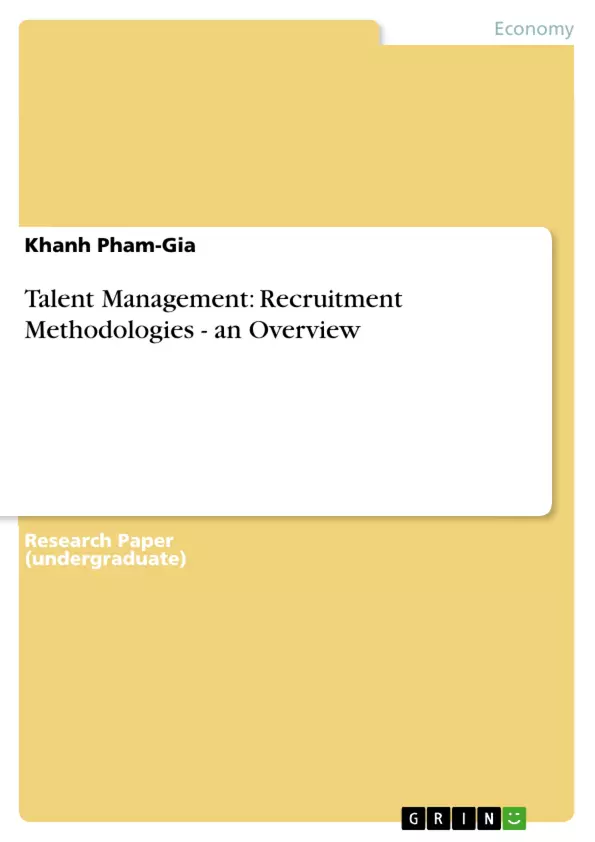Employees take a centre stage in companies and play the essential role for business success. Hence, companies have the highest interest to recruit and keep high qualified manpower. In this study, an overview about recruitment methodologies is provided. Additionally, benefits and drawbacks of recruiting methods are analyzed and compared.
Recruitment is the discovering and obtaining of potential applicants for actual or anticipated organizational vacancies. Except the recruiting methods applied, many factors could influence the recruiting efforts: image of the organization, attractiveness and nature of the job, internal policies, government requirements, and recruiting budget.
There are a high number of recruiting methods which can be classified in different ways: active and passive, internal and external, print and digital methods. The principle sources of recruiting employees include internal search, advertisements (in print or digital media), employee referrals, employment agencies, educational institutions and unsolicited applicants. Recruitment alternatives such as temporary staffing services, employee leasing, and independent contractors can be used meaningfully to acquire the temporary manpower.
Because of benefits and drawbacks of different recruiting methods, the task of HR management is to select and apply the right method for an efficient and effective recruiting. The recruiting process provides a basis for the selection of the right candidate and should be well accomplished.
Inhaltsverzeichnis (Table of Contents)
- Executive Summary
- Table of Contents
- List of Abbreviations
- List of Tables and Figures
- 1 Introduction
- 2 Main Part
- 2.1 Recruiting goals and influencing factors
- 2.2 Classification of recruiting methods
- 2.3 Analysis of individual recruiting methods
- 2.3.1 Traditional recruiting versus e-Recruiting
- 2.3.2 Printed versus digital advertisement
- 2.3.3 Employment agencies
- 2.3.4 Employee referrals
- 2.3.5 Schools, colleges, and universities
- 2.3.6 Unsolicited applications
- 2.3.7 Recruitment alternatives
- 3 Conclusion
- 4 ITM Checklist
Zielsetzung und Themenschwerpunkte (Objectives and Key Themes)
This study provides an overview of recruitment methodologies, analyzing the benefits and drawbacks of different recruiting methods. The main objective is to highlight the crucial role of effective recruitment in securing highly qualified manpower for business success. Key themes explored include: * **The importance of employee recruitment for organizational success.** * **The diverse range of recruiting methods available.** * **The benefits and drawbacks of different recruiting approaches.** * **The factors that influence the effectiveness of recruiting efforts.** * **The application of technology in modern recruitment practices.**Zusammenfassung der Kapitel (Chapter Summaries)
The text begins by emphasizing the central role of employees in achieving business success and the importance of recruitment in attracting qualified personnel. The study then delves into the various factors that can influence recruiting efforts, including the company's image, job attractiveness, internal policies, and external regulations. The text explores different classifications of recruiting methods, including active and passive, internal and external, and print and digital approaches.
The analysis of individual recruiting methods examines traditional and e-recruiting practices, comparing the effectiveness of printed and digital advertisements. It also delves into the roles of employment agencies, employee referrals, educational institutions, and unsolicited applications. The text concludes by discussing recruitment alternatives such as temporary staffing, employee leasing, and independent contracting.
Schlüsselwörter (Keywords)
The text focuses on the key concepts of employee recruitment, human resource management, talent acquisition, recruiting methodologies, traditional and e-recruiting, printed and digital advertising, employment agencies, employee referrals, and recruitment alternatives. It explores the benefits and drawbacks of various recruitment methods, aiming to provide insights for effective talent management in organizations.- Citation du texte
- Khanh Pham-Gia (Auteur), 2008, Talent Management: Recruitment Methodologies - an Overview, Munich, GRIN Verlag, https://www.grin.com/document/132194



